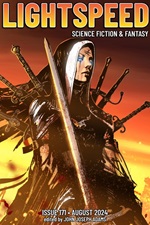“Mud Maidens Rise” by K. A. Wiggins
“The Darkness Between the Stars” by Richard Thomas
“Look at the Moon” by Dominique Dickey
“Resistance” by Cat Rambo
“What’s in a Name” by Matthew Hughes
“The Quality of Mercy Is Not Strain’d” by Archita Mittra
“Child of the River” by Oluwatomiwa Ajeigbe
“Under the Skin” by Deborah L. Davitt
Reviewed by Victoria Silverwolf
Seven short stories and a single novelette appear in this issue.
“Mud Maidens Rise” by K. A. Wiggins is difficult to describe, as it is almost all mood and imagery, with little or no plot. If I am interpreting it correctly, it describes how you used to fly and walk on water, until you began to perceive hidden things. This brief prose poem is full of vivid details, if not much comprehensible narrative.
In “The Darkness Between the Stars” by Richard Thomas, the narrator enters a time machine in an abandoned theme park. He journeys far into the future, then into the recent past. The experience changes his relationships with others.
Although the story contains a few speculative elements indicating that it begins in the future, for all practical purposes it is pure fantasy rather than science fiction. There is no real explanation for the existence of the time machine. The narrator’s voyage into futurity is interesting, but only his trip to the past is relevant to the apparent theme, which seems to be developing empathy for one’s elders.
“Look at the Moon” by Dominique Dickey is the magazine’s only novelette. Two lovers join a stargazing party that turns out to be much more sinister than expected. The encounter leads to a desperate act by one of them, and the revelation of the fate of the other.
The basic plot outlined above is that of a typical supernatural horror story. In addition to this familiar storyline, much of the text deals with religious faith, relationships between parents and children, romance, sexuality, and gender. Dealing with all these matters in an otherwise ordinary tale of terror reveals great ambition on the part of the author. In addition to the disparity between genre and content, I found the climax too reliant on a remarkable coincidence.
Less than three hundred words long, “Resistance” by Cat Rambo describes how humanity fought off various aliens, until they encountered those they could accept. There is not much more to this tiny work, which may offer a little food for thought.
“What’s in a Name” by Matthew Hughes retells the story of Rumpelstiltskin from the point of view of that oddly named being. Most of the text follows the familiar plot, albeit narrated in a wisecracking way. The ending turns the tale on its head. The work as a whole provides some amusement and perhaps a bit of pathos.
“The Quality of Mercy Is Not Strain’d” by Archita Mittra is the second story in a row with a title taken from Shakespeare. The protagonist, addressed as “you” in the currently popular technique of second person narration, works for an interstellar corporation. You meet a robot at a diner that has been abandoned for centuries, returning to the place now and then to talk to it. You try to figure out a way to repair the deteriorating machine, and to escape your indenture to the corporation.
This synopsis and the story’s futuristic setting make it sound like space opera adventure, but in fact this is a quiet, introspective tale. Much of the text consists of flashbacks relating how the main character became an enhanced servant of the corporation with an extended lifespan. Second person narration is trendy these days; in this particular case, it neither helps nor hinders the story very much, but runs the risk of seeming pretentious and arty.
The narrator of “Child of the River” by Oluwatomiwa Ajeigbe is the son of a mother associated with wind spirits and a father linked in the same way to fire spirits. He is connected to the spirits of water, has dreams of drowning, and is eventually drawn to the river.
The fantasy premise is a simple one, and the narrator’s fate is predictable from the start. Perhaps the most interesting part of this mythic tale is that it takes place in the modern world. The contrast between nature spirits and technology adds some originality to an otherwise familiar story.
The narrator of “Under the Skin” by Deborah L. Davitt has programmable tattoos. At first this was for the sake of fashion, but a financial crisis made it necessary to sell them to advertising agencies. When this attempt to turn the narrator into a living commercial collapsed, hackers used the tattoos to produce racist and otherwise offensive messages, forcing the narrator to withdraw from society.
The author manages to make the premise, as well as the way it can be abused, seem plausible. The story can be read as an allegory for the way that social media and other forms of communication can be corrupted. In little more than one thousand words, the work offers an intriguing problem, and a hint of hope that it might be solvable.
Victoria Silverwolf is surprised that this issue’s shortest story is accompanied by an author spotlight, but the longest one is not.
 Lightspeed
Lightspeed